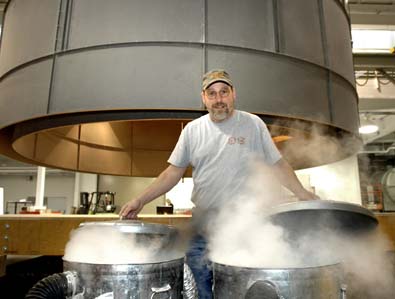Inside Iowa State
Inside ArchivesSubmit newsSend news for Inside to inside@iastate.edu, or call (515) 294-7065. See publication dates, deadlines. About InsideInside Iowa State, a newspaper for faculty and staff, is published by the Office of University Relations. |
April 29, 2005 Wind lab's utility infielderby Mike Krapfl The crew from National Geographic's Explorer television show needed some help. Could somebody please paint the Styrofoam packing peanuts swirling below Iowa State University's tornado simulator? Pink just wouldn't do. Well, sure, Bill Rickard could. But have you ever tried to coat packing peanuts with spray paint? The spray just blows them away. Not if you're Rickard, a 52-year-old laboratory mechanical technologist in Howe Hall's Wind Simulation and Testing Laboratory. He went back to his shop and unrolled some wire mesh. The same stuff is used in the tornado simulator to keep packing peanuts, tiny models of houses and anything else from flying into the simulator's big fan. Rickard made a little cage with the leftover wire, put in the peanuts and painted them a nice brown. "I'm the notorious scrounger," Rickard said recently. "I have a lot of stuff tucked away." That's because he never knows what researchers -- or camera crews -- are going to ask for next. 
Bill Rickard with the dry ice "pumps" he engineered and built to help observers see the wind effects in Iowa State's tornado simulator (behind him). Photo by Bob Elbert. He knows science, tooA green laser shot into another simulated tornado as the National Geographic crew shot more footage. "What's that laser do?" asked Bill Gallus, an associate professor of geological and atmospheric sciences, as he watched from the sidelines. Rickard, standing nearby in his steel-toed boots with the leather worn off the toes, was right there to offer a quick explanation of Particle Image Velocimetry. It's a technique researchers use to record instant velocity measurements in an air flow. Rickard said it's a common tool in a wind tunnel. And now the same idea is being applied to measure the wind velocity in tornadoes. And that's a nice thing about working with Rickard, said Fred Haan, assistant professor of aerospace engineering. Rickard not only knows his way around his shop. He knows his way around the science there, too. When there's an experiment to plan or set up, Haan said Rickard will do his own research to see if other labs have come up with a little trick that could be useful in Iowa State's lab. "It's all really helpful," Haan said. "It's like having another research assistant." Rickard said he's always liked science. And he's found aerospace engineering particularly fascinating. "I've learned an awful lot about things I never would have thought I'd learn," he said. "I understand a lot of the science, but not a lot of math behind the science." An Iowa StaterRickard grew up in Sioux City and was never far from a wood shop and power tools. His father owned a cabinetmaking business. And his father put him right to work. "I had my first tetanus shot at 2," Rickard said. "Dad had me on a job site showing me how to pull nails out." Rickard left the shop to study agronomy at Iowa State. He earned his degree, did a little farming and returned to the family business. When his dad retired, Rickard returned to campus thinking he'd go back to school. He found part-time work in the Engineering Research Institute's wood shop. Before long he was working full time to run the shop. He ran the institute's shop for about 10 years and then moved to the wind lab's shop in 1999. His agenda for a recent workday included setting up wind tunnels for student labs, working on air compressor filters, building models for the wind tunnels, setting up the next experiment, keeping the lab tidy and working with a crew of students. Kyle Andringa, a senior in aerospace engineering from Lincoln, Neb., works in the lab and said Rickard is great with the students. He said that's because there's enough to do around the lab that Rickard needs their help. And he has a knack for relating to them. "Bill is almost an undergraduate with you," Andringa said. "He's so friendly. I talk to him just like I talk to one of my friends." Rickard said he enjoys working with Andringa and the other students. He also enjoys the researchers who keep him busy. And he loves what he does for a living. "It's very, very interesting work," he said. "It's never the same thing. And there's always a list of problems to solve." Try this at homeBill Rickard spends his spare time building furniture, paddling canoes, caring for a sheep dog and thinking up ways to make homemade tornadoes. Here's one of his recipes: Ingredients: A rectangular cardboard box, a vacuum cleaner and a pan of water with a little dry ice in it
|
Quote"I had my first tetanus shot at 2. Dad had me on a job site showing me how to pull nails out." Bill Rickard |